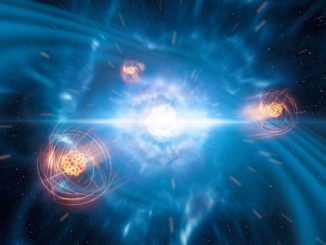
In August, gravitational waves generated in the merger of two neutron stars in a galaxy 130 million light years away reached Earth, the first such collision to be detected across the electromagnetic spectrum as well as the tell-tale ripples in spacetime predicted by Einstein’s general theory of relativity.
A careful analysis of the merger using U.S. National Science Foundation radio telescopes has detected a narrow jet of particles streaming away into space at nearly the speed of light.
Because of the angle between the jet and line of sight to Earth, it initially appeared the particles were moving four times faster than light, said Kunal Mooley, a researcher at the U.S. National Radio Astromomy Observatory (NRAO) and the California Institute of Technology. But the analysis shows it actually streaming away at “just” 97 percent light speed.
Detection of the jet supports theoretical predictions and current thinking about high-energy gamma ray bursts, which are seen when their powerful jets are pointed at or nearly at Earth.
The jet from the neutron star merger, known as GW170817, was first observed by the NSF’s Very Long Baseline Array, the Karl G. Jansky Very Large Array and the Robert C. Byrd Green Bank Telescope 75 days after the neutron star merger. It was observed again 155 days later.
The observed apparent motion indicated a “superluminal” velocity, but “based on our analysis, this jet most likely is very narrow, at most 5 degrees wide, and was pointed only 20 degrees away from the Earth’s direction,” said Adam Deller of the Swinburne University of Technology. “But to match our observations, the material in the jet also has to be blasting outwards at over 97 percent of the speed of light,”
The most likely scenario is that the initial merger triggered a cataclysmic explosion that blasted a spherical shell of debris outward. The neutron stars collapsed into a black hole that created a rapidly spinning disk of debris that generated two polar jets that streamed away in opposite directions.

Jets are believed to be common in such events, but they were not initially seen ion this case because they first had to break through the shell of debris cast outward by the initial merger. The jets first formed a cocoon-like billowing in the shell before they finally broke out into open space.
“Our interpretation is that the cocoon dominated the radio emission until about 60 days after the merger, and at later times the emission was jet dominated,” said theorist Ore Gottlieb, of the Tel Aviv University.
Added Gregg Hallinan of the California Institute of Technology: “We were lucky to be able to observe this event, because if the jet had been pointed much farther away from Earth, the radio emission would have been too faint for us to detect.”
Detection of the jet strengthens a connection between neutron star mergers and high-energy gamma ray bursts, which are seen when their jets are pointed in Earth’s general direction.
“The merger event was important for a number of reasons, and it continues to surprise astronomers with more information,” said Joe Pesce, NSF Program Director for the U.S. National Radio Astonomy Observatory.
“Jets are enigmatic phenomena seen in a number of environments, and now these exquisite observations in the radio part of the electromagnetic spectrum are providing fascinating insight into them, helping us understand how they work.”



